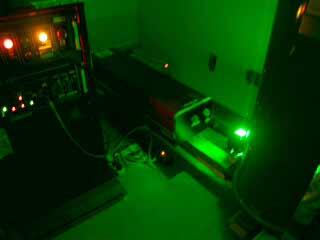2 September, 2003
Science Profile: LIDAR
LIDAR stands for light detecting and ranging. Here at McMurdo, a LIDAR instrument is installed next to the lab that I work in. It is essentially a large green laser that shines directly into the night sky. If there are any clouds in the sky, the light will backscatter toward the ground where a telescope collects this light and amplifies it for the electronic detector. It is really a beautiful sight to see a green beam of light infinitely extend into a black sky. And it is very interesting to observe the signal that it produces.
You can figure out how high clouds are by the time it takes for the laser to bounce back down. The higher the clouds, the longer it takes. By using different wavelengths of light it is possible to infer the size and concentration of the droplets or ice crystals in the clouds. Together this information gives us needed data on polar stratospheric clouds which are important in the ozone depletion cycle. We want to launch an Optical Parcticle Counter, but we need parcticles to count. So we are waiting until the LIDAR instrument indicates the presence of these clouds. In the last two days we have had no response. In years past they sometimes have not been able to launch at all because no clouds are present above McMurdo. Hopefully our luck will be better!
Today, I worked in the lab calibrating the instruments and soldering wires. It snowed this morning, a really dry powdery snow that warmed the air. When it snows you may notice the air warms up. This is because the water needs to release its heat energy to the air before it can become snow. That is why the temperature often hovers at just around freezing for long periods of time as the water turns to snow.

This is a view of the power supply and Laser, the light is reflecting off a mirror to hole in the roof.

Paola working on the Lidar instrumentation.

A view from the roof, the white bars are the railings, the green laser just disappears in the sky.
Contact the TEA in the field at
.
If you cannot connect through your browser, copy the
TEA's e-mail address in the "To:" line of
your favorite e-mail package.
|
